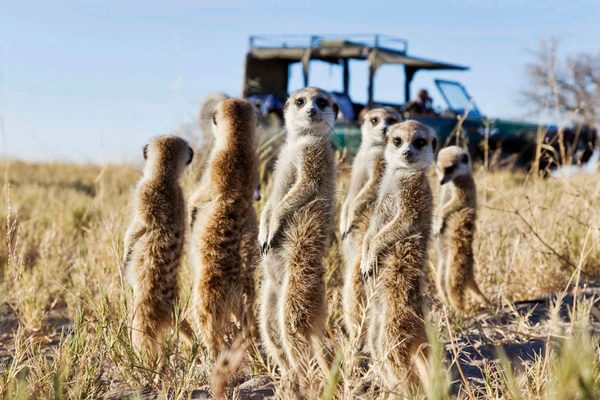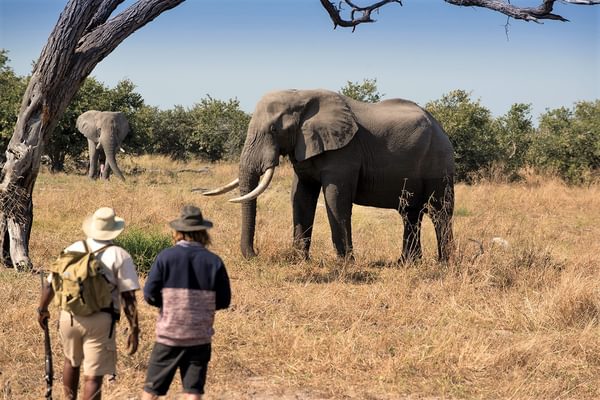Speak To Our Botswana Specialist Today
and start planning your tailor-made holiday

Richard
Travel Expert

Can't decide where to go? Why not peruse some of our most popular destinations for inspiration then give us a call!

A diverse land brimming with superb safaris, pristine sandy beaches, towering snow-capped peaks and tropical underwater worlds is just waiting to welcome you

Australia offers vibrant cities, diverse landscapes, and iconic wonders like the Great Barrier Reef. New Zealand adds dramatic scenery, Maori culture, and relaxed charm. Together, they promise nature, adventure, culture, and warm hospitality.

If you're dreaming of an island getaway, look no further than the Caribbean with its gorgeous soft sand beaches and lively, diverse cultures.

Head to the amazing destination that is Central America, full of the knowledge of ancient civilizations, incredible mountains, and beautiful beaches.

Discover vibrant cultures, pristine beaches, and tantalizing flavours in the captivating travel haven that is East and Southeast Asia

Embark on a journey through the vibrant tapestry of India, Sri Lanka, and Bhutan—where ancient temples, lush tea plantations, and soaring Himalayan peaks promise unforgettable moments at every turn.

Picture yourself basking on sun-kissed beaches, sipping tropical cocktails beneath swaying palms —where crystal-clear lagoons and luxurious resorts cater to your every desire.

Experience world-class hospitality, mouthwatering cuisines, and the region’s deep-rooted cultural traditions for an unforgettable Middle East adventure.

Venture to the ends of the Earth and behold the icy majesty of polar landscapes. Discover pristine solitude, exhilarating expeditions, and breathtaking views that promise a memorable encounter with nature at its most dramatic

Journey into the heart of South America, where the rhythmic pulse of its vibrant cities meets the majesty of the Amazon rainforest and the timeless wonder of ancient civilizations.

The South Pacific is a paradise of turquoise waters, white-sand beaches, and vibrant island cultures. From adventure and natural beauty to pure relaxation, each island offers its own unique charm and welcome.

From the soaring plains of the Southwestern USA to the stunning landscapes of the expanses of Canada, visit some of the most impressive scenery in the world

If you are looking for a trip to knock iconic locations off your bucket list, check out our buck list recommendations

From the graceful stride of giraffes at sunrise to the echoing roars of lions beneath starlit skies, each of our safaris promises an unforgettable dance with nature.


Our family holidays are a perfect opportunity to create lasting memories, whether exploring new destinations or simply enjoying quality time together. From adventure-filled escapes to relaxing beach retreats, they offer a chance to reconnect and unwind away from daily routines.

Our luxury holidays offer the finest experiences, from exclusive resorts and private villas to tailor-made adventures with impeccable service.

For those seeking adventure beyond the usual tourist trails, our off-the-beaten-track trips take you to some of the world’s most remote and untouched destinations, where authentic cultural encounters and breathtaking landscapes await. Let us craft your unique journeys that few travellers ever experience.

For the ultimate beach escape, we offer luxury holidays to some of the world’s most stunning coastal destinations, from the white-sand shores of Antigua to the turquoise waters of Zanzibar.

For those who crave excitement and exploration, our adventure holidays take you to some of the world’s most thrilling destinations, whether trekking through Patagonia, summiting Mount Kenya, or kayaking past icebergs in Antarctica.

Interested in something a bit more focused? How about a horse-riding holiday through Argentina? Or a photography safari? Look through our Special Interest holiday selection for inspiration

Our wildlife holidays invite you to step into unique ecosystems and experience amazing animal encounters. Whether spotting majestic tigers in the jungles of India or marvelling at polar bears in the Arctic, each trip promises awe-inspiring moments steeped in the magic of nature.

Our small group tours offer the perfect balance of expert-guided exploration and personal experience, taking you to incredible destinations with like-minded travellers. Whether it's a wildlife safari in Botswana, a cultural journey through Vietnam, or a chef-led expedition through India, our carefully curated itineraries ensure an intimate, enriching, and hassle-free experience.

Sustainability travel is at the core of what we do and a guiding principle in every choice we make as a business. Let us help you make sustainable travel choices

Read about what we do to make a difference

One of the most important parts of our commitment to responsible travel is protecting our clients, and it is a part that we take extremely seriously.

Not sure what's best for which time of year? Check out our expert-written guides

Looking for some expertise on your destination? Have a look through our selection of guides and articles written by our destination experts

Looking for more inspiration? Read from our range of hundreds of articles from our travel specialists, local guides, and personal travel tales.

Our mission is to make every holiday special. We will do this whilst specifically aiming to minimise the environmental impact of our activity and maximise our opportunity to influence others to do the same.
Leopards are notoriously elusive, and so are on many visitor’s safari bucket list. If you are keen to spot a leopard, then a Botswana safari is a fantastic choice as they are the most common cat here.
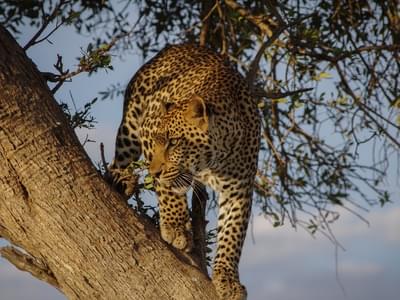
Leopards are notoriously elusive, and so are on many visitor’s safari bucket list. If you are keen to spot a leopard, then a Botswana safari is a fantastic choice as they are the most common cat here.
My initial idea for this blog was to give an overview of the best places and camps to see leopards. However, being lucky enough to stay at most camps in Botswana and on several occasions, I found it difficult to pin down one area or camp that stood out from the rest.
The truth of it is that Northern Botswana, in particular, has an incredibly high number and density of leopards, which in my eyes makes this incredible country one of the best places in Africa to spend time with them, up there with the Luangwa Valley in Zambia.
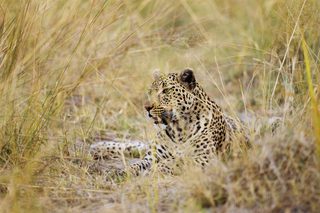
Leopards are found throughout and Okavango Delta. Its riverine environment, combining tall grasses, dense large trees and high prey numbers, makes it the perfect habitat to hide, hunt and thrive in the numbers they do today.
Countless times I have stayed in different parts of the delta, be it in the west, north, east, south or the centre have had multiple leopard sightings in the space of three or four hours, when I think back to these game drives in more detail they all had one thing in common, the time of year.
Some of my best leopard sightings have been in Khwai and the Kwara concession. I think this is most likely down to the number of eyes looking for them.
Also, unlike in the national parks and reserves, night drives are permitted in the Khwai community concession and the private concessions.
In the Kwara concession, both Splash Camp and Kwara Camp are owned and run by Kwando Safaris, who have a guide and tracker set up. This is rare for camps in Botswana, where you usually just have a guide. Two pairs of trained eyes greatly increase your chances of coming across and spotting sightings of interest.
Khwai is similar, and although the camps are not using guides and trackers, the Khwai community concession is open to a number of camps and self-driving vehicles.
The increased numbers make the leopards more comfortable around vehicles and greatly improve the chances of coming across them or someone else who has seen them. Camps operating in this area are Machaba Camp, Little Machaba, Khwai Tented, Khwai Bush Camp, and Khwai River Camp, as well as the community-run campsites for self-drives.
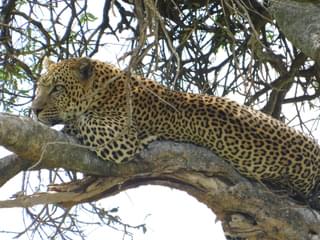
I often hear how Botswana is best visited between July and October and in general, I disagree as the wildlife in the Okavango Delta is incredible all year round. However, in the case of spotting leopards, I would agree.
Leopards are elusive animals, usually hunting under the cover of darkness or during dusk and dawn. Their behaviour makes them difficult animals to find and are often only spotted due to a bit of luck and/or good tracking skills.
From November through to April time Botswana receives its annual rains, with plenty of surface water, many of the prey species are dispersed thinly due to the readily available water everywhere. The grasses are tall, and the trees and bushes are green, thick, and lush, making the spotting of shy animals like leopards even more difficult.
In my experience as a guide and guest, July through to the end of October/beginning of November is optimum, and the later in this period you can travel, the better. As the grasses and foliage begin to die back, the terrain becomes a lot more exposed. This, combined with fewer water sources the chances of seeing the usually hidden leopard much higher.
It is a common misconception that leopards spend the majority of their time when they are not hunting resting over a branch up a tree.
Although this is not strictly false, they mainly use the height advantage when they have already made a kill and are keeping it out of reach from other predators.
With this in mind it's essential to make sure you are also looking under suitable bushes and also on termite mounts and other raised areas. In areas with few trees, such as the Central Kalahari Game Reserve, this is particularly important.
Many of Botswana’s predators, especially in the wetter areas to the North, tend to be in higher densities in similar areas. From my experience, these areas tend to be North of Chiefs Island and then down the Eastern side of the Okavango Delta; these areas have more expanses of dry land with year-round permanent flowing tributaries providing both water and prey.
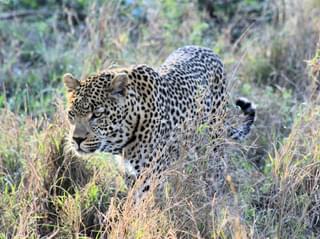
In conclusion, Botswana has a great leopard population throughout and really is a stronghold for the species. Going on safari to any of the Northern Botswana camps, you would be unlucky not to have a leopard sighting, if not, multiple sightings.
However, if you are particularly fond of leopards and want to base your safari around the best places and times to see them, follow the advice above or give me a ring to arrange a ‘leopard’ safari for you.
Wondering when to visit? Take a look at this guide on the best time to visit Botswana.
Looking for some more inspiration? Take a look at our best safari holiday ideas, our favourite family safaris, our big five safari guide, or our top African safari honeymoon suggestions.
and start planning your tailor-made holiday

Travel Expert
What can I say….my son and myself had the most wonderful time in Kenya thanks to the first-class itinerary that Ben and Louise put together for us. We spoke with Ben many times to ensure he ‘got it right’. This was our 2nd visit to Kenya, and it certainly lived up to our expectations and memories. Nothing was too much trouble for all the staff; we cannot have been looked after any better. I would highly recommend Far and Wild; they are so knowledgeable and have personally visited the lodges and areas. We are already planning another visit, and we cannot wait.
I have just returned from the most amazing trip to Tanzania, booked with Far & Wild. Everything went so smoothly from the first time I spoke with them. The planning was great, the itinerary was perfect for us, and the lodges were amazing. We spent 10 nights with an amazing guide, travelling through Northern Tanzania and even got to see the migration, which was a lifetime ambition of mine. This wasn't our first safari, so we were nervous as to how it would compare, but it was spot on. I will certainly be using them again to book our next trip....we're thinking of a relaxing beach stay next time to get over the excitement of safari!
Just back from another amazing F&W organised trip to Namibia with the family (8 adults). Having been there before, Alistair tailored our trip to include our favourite locations and added a new one for us, which we loved.The quality of accommodation and guiding, activities, food and drinks was exceptional throughout. It was good value for the level of luxury we had.
We had a wonderful trip to São Tomé and Príncipe - a small island nation in the Gulf of Guinea with paradise (almost empty) beaches and jungle forest. It was all well organised by Far and Wild and we stayed at a great combination of different types of resorts/hotels. We really recommend this for those who want to experience a pristine destination with few other tourists and friendly and welcoming people. The islands also feel very safe. At Principe, there are no dangerous animals, snakes or whatever, and it was great to be able to hike in the jungle without being very conscious of where to put your hands and feet. Go before everyone else does!
Back home again, basking in the joys of a superb safari. Every aspect you arranged for us, including linking up with Mack Air and Wild Horizons locally to transport us. The choice of camps was ideally situated, comfortable, in good surroundings, and with excellent wildlife on the doorstep and throughout the wider country. The service staff in each looked after us very well, catering was excellent, and the game guides were professional, knowledgeable and helpful. You made us happy, and we recommend you to similar safari enthusiasts with confidence.
Far and Wild went above and beyond to make sure my trip to Zambia was special. I would definitely recommend them and their services to anyone wanting to travel to Africa.
Lovely holiday at the amazing Almanara on Galu beach, a beach like no other. Far and Wild excelled themselves from beginning to end of our holiday in beautiful Kenya.... What a country!,
Wow! These guys are amazing. Can’t recommend them highly enough. Friendly AND efficient! Sorted out our trip (last minute and lots of different family member needs, sorry!) in record time and everything worked like clockwork. Trip of a lifetime to the Masai Mara. Will be back (and use F&W again!)!
It was a dreamy holiday on the Kenyan Coast - Far and Wild, their efficiency and professionalism allowed us to relax and be the happiest family alive !! We cannot fault them, their care and understanding of what we wanted from a holiday ensured we had the most memorable trip. We will be booking with them again for sure!
Get travel tips directly to your inbox every week
Give us a call on 0203 111 1315 or fill in the form below and we’ll be in touch.

